Effect of Sonication Batch on Electrical Properties of Graphitic-Based PVDF-HFP Strain Sensors for Use in Health Monitoring
Abstract
:1. Introduction
2. Materials and Methods
2.1. Tools and Materials
2.1.1. Materials
2.1.2. Test Devices
- Manufacturing facilities: For the ultrasonication process, a HIELSCHER® (Tellow, Germany) Ultrasonic Processor UP400ST machine was used. The evaporation process was carried out in a BINDER ED23 oven.
- Microstructural characterization: Scanning electron microscopy from PHILIPS® (Amsterdam, Netherlands) (SEM—XL 30 ESEM) and transmission electron microscopy from JEOL® (Tokyo, Japan) (TEM—JEM 1010) facilities from the university were used.
- Electrical characterization: DC tests were performed using a KEITHLEY® (Cleveland, OH, USA) Source Meter Unit instrument (Series 2400 SourceMeter). The AC tests were performed by electrical impedance spectroscopy (EIS) using a METROHM (Madrid, Spain) Autolab potentiostat (PGSTAT302N station).
- Electromechanical tests: The quasi-static and cyclic tensile tests were performed on a ZWICK® (Barcelona, Spain) universal tensile machine with a 500 N load cell (ProLine Z100). During these tests, the electrical response was recorded with an Agilent test unit at an acquisition frequency of 10 Hz (34410A multimeter).
2.2. Film Preparation
2.3. Nanoparticle Characterization
2.4. Electrical Characterization
2.5. Electromechanical Characterization
2.6. Proof-of-Concept Tests
3. Results and Discussion
3.1. Microstructural Analysis
3.2. DC Electrical Properties
3.3. AC Electrical Properties: Modeling of the Electrical Behavior via EIS
3.4. Quasi-Static and Cyclic Tests
3.5. Proof-of-Concept Tests
4. Conclusions
Author Contributions
Funding
Institutional Review Board Statement
Informed Consent Statement
Data Availability Statement
Conflicts of Interest
References
- Vaghasiya, J.V.; Mayorga-Martinez, C.C.; Pumera, M. Wearable Sensors for Telehealth Based on Emerging Materials and Nanoarchitectonics. npj Flex. Electron. 2023, 7, 26. [Google Scholar] [CrossRef] [PubMed]
- Heikenfeld, J.; Jajack, A.; Rogers, J.; Gutruf, P.; Tian, L.; Pan, T.; Li, R.; Khine, M.; Kim, J.; Wang, J.; et al. Wearable Sensors: Modalities, Challenges, and Prospects. Lab Chip 2018, 18, 217–248. [Google Scholar] [CrossRef]
- Ates, H.C.; Nguyen, P.Q.; Gonzalez-Macia, L.; Morales-Narváez, E.; Güder, F.; Collins, J.J.; Dincer, C. End-to-End Design of Wearable Sensors. Nat. Rev. Mater. 2022, 7, 887–907. [Google Scholar] [CrossRef]
- Pawar, T.; Chaudhuri, S.; Duttagupta, S.P. Body Movement Activity Recognition for Ambulatory Cardiac Monitoring. IEEE Trans. Biomed. Eng. 2007, 54, 874–882. [Google Scholar] [CrossRef]
- Dolson, C.M.; Harlow, E.R.; Phelan, D.M.; Gabbett, T.J.; Gaal, B.; McMellen, C.; Geletka, B.J.; Calcei, J.G.; Voos, J.E.; Seshadri, D.R. Wearable Sensor Technology to Predict Core Body Temperature: A Systematic Review. Sensors 2022, 22, 7639. [Google Scholar] [CrossRef]
- Lin, J.; Fu, R.; Zhong, X.; Yu, P.; Tan, G.; Li, W.; Zhang, H.; Li, Y.; Zhou, L.; Ning, C. Wearable Sensors and Devices for Real-Time Cardiovascular Disease Monitoring. Cell Rep. Phys. Sci. 2021, 2, 100541. [Google Scholar] [CrossRef]
- Tang, C.; Liu, Z.; Li, L. Mechanical Sensors for Cardiovascular Monitoring: From Battery-Powered to Self-Powered. Biosensors 2022, 12, 651. [Google Scholar] [CrossRef]
- Bijender; Kumar, A. Flexible and Wearable Capacitive Pressure Sensor for Blood Pressure Monitoring. Sens. Biosens. Res. 2021, 33, 100434. [Google Scholar] [CrossRef]
- Ullah, H.; Wahab, M.A.; Will, G.; Karim, M.R.; Pan, T.; Gao, M.; Lai, D.; Lin, Y.; Miraz, M.H. Recent Advances in Stretchable and Wearable Capacitive Electrophysiological Sensors for Long-Term Health Monitoring. Biosensors 2022, 12, 630. [Google Scholar] [CrossRef] [PubMed]
- Hassan, M.; Abbas, G.; Li, N.; Afzal, A.; Haider, Z.; Ahmed, S.; Xu, X.; Pan, C.; Peng, Z. Significance of Flexible Substrates for Wearable and Implantable Devices: Recent Advances and Perspectives. Adv. Mater. Technol. 2022, 7, 2100773. [Google Scholar] [CrossRef]
- Del Bosque, A.; Sánchez-Romate, X.F.; Sánchez, M.; Ureña, A. Wearable Sensors Based on Graphene Nanoplatelets Reinforced Polydimethylsiloxane for Human Motion Monitoring: Analysis of Crack Propagation and Cycling Load Monitoring. Chemosensors 2022, 10, 75. [Google Scholar] [CrossRef]
- Colgate, J.E.; James, E.; IEEE Robotics and Automation Society; Institute of Electrical and Electronics Engineers. In Proceedings of the IEEE Haptics Symposium (2015: Evanston, Ill.) 2015 IEEE World Haptics Conference (WHC): The 6th Joint Eurohaptics Conference and IEEE Haptics Symposium. Evanston, IL, USA, 22–26 June 2015; IEEE: Piscataway, NJ, USA, 2015. ISBN 9781479966240.
- Bidsorkhi, H.C.; D’aloia, A.G.; Tamburrano, A.; De Bellis, G.; Sarto, M.S. Waterproof Graphene-pvdf Wearable Strain Sensors for Movement Detection in Smart Gloves. Sensors 2021, 21, 5277. [Google Scholar] [CrossRef] [PubMed]
- Alsulami, Q.A.; Wageh, S.; Al-Ghamdi, A.A.; Bilal, R.M.H.; Saeed, M.A. A Tunable and Wearable Dual-Band Metamaterial Absorber Based on Polyethylene Terephthalate (PET) Substrate for Sensing Applications. Polymers 2022, 14, 4503. [Google Scholar] [CrossRef] [PubMed]
- Zhao, X.; Hua, Q.; Yu, R.; Zhang, Y.; Pan, C. Flexible, Stretchable and Wearable Multifunctional Sensor Array as Artificial Electronic Skin for Static and Dynamic Strain Mapping. Adv. Electron. Mater. 2015, 1, 1500142. [Google Scholar] [CrossRef]
- Chen, T.; Wu, G.; Panahi-Sarmad, M.; Wu, Y.; Xu, R.; Cao, S.; Xiao, X. A Novel Flexible Piezoresistive Sensor Using Superelastic Fabric Coated with Highly Durable SEBS/TPU/CB/CNF Nanocomposite for Detection of Human Motions. Compos. Sci. Technol. 2022, 227, 109563. [Google Scholar] [CrossRef]
- Yue, X.; Jia, Y.; Wang, X.; Zhou, K.; Zhai, W.; Zheng, G.; Dai, K.; Mi, L.; Liu, C.; Shen, C. Highly Stretchable and Durable Fiber-Shaped Strain Sensor with Porous Core-Sheath Structure for Human Motion Monitoring. Compos. Sci. Technol. 2020, 189, 108038. [Google Scholar] [CrossRef]
- Li, S.; Li, R.; González, O.G.; Chen, T.; Xiao, X. Highly Sensitive and Flexible Piezoresistive Sensor Based on C-MWCNTs Decorated TPU Electrospun Fibrous Network for Human Motion Detection. Compos. Sci. Technol. 2021, 203, 108617. [Google Scholar] [CrossRef]
- del Bosque, A.; Sánchez-Romate, X.F.; Gómez, A.; Sánchez, M.; Ureña, A. Highly Stretchable Strain Sensors Based on Graphene Nanoplatelet-Doped Ecoflex for Biomedical Purposes. Sens. Actuators A Phys. 2023, 353, 114249. [Google Scholar] [CrossRef]
- Madhavan, R. Flexible and Stretchable Strain Sensors Fabricated by Inkjet Printing of Silver Nanowire-Ecoflex Composites. J. Mater. Sci. Mater. Electron. 2022, 33, 3465–3484. [Google Scholar] [CrossRef]
- Ahamed, B.; Sellamuthu, S.; Karri, P.N.; Srinivas, I.V.; Mohammed Zabeeulla, A.N.; Ashok Kumar, M. Design of an Energy-Efficient IOT Device-Assisted Wearable Sensor Platform for Healthcare Data Management. Meas. Sens. 2023, 30, 100928. [Google Scholar] [CrossRef]
- Zheng, Q.; Lee, J.H.; Shen, X.; Chen, X.; Kim, J.K. Graphene-Based Wearable Piezoresistive Physical Sensors. Mater. Today 2020, 36, 158–179. [Google Scholar] [CrossRef]
- Chen, K.Y.; Xu, Y.T.; Zhao, Y.; Li, J.K.; Wang, X.P.; Qu, L.T. Recent Progress in Graphene-Based Wearable Piezoresistive Sensors: From 1D to 3D Device Geometries. Nano Mater. Sci. 2022, 5, 247–264. [Google Scholar] [CrossRef]
- Obitayo, W.; Liu, T. A Review: Carbon Nanotube-Based Piezoresistive Strain Sensors. J. Sens. 2012, 2012, 652438. [Google Scholar] [CrossRef]
- Zhai, W.; Xia, Q.; Zhou, K.; Yue, X.; Ren, M.; Zheng, G.; Dai, K.; Liu, C.; Shen, C. Multifunctional Flexible Carbon Black/Polydimethylsiloxane Piezoresistive Sensor with Ultrahigh Linear Range, Excellent Durability and Oil/Water Separation Capability. Chem. Eng. J. 2019, 372, 373–382. [Google Scholar] [CrossRef]
- Zhai, Y.; Yu, Y.; Zhou, K.; Yun, Z.; Huang, W.; Liu, H.; Xia, Q.; Dai, K.; Zheng, G.; Liu, C.; et al. Flexible and Wearable Carbon Black/Thermoplastic Polyurethane Foam with a Pinnate-Veined Aligned Porous Structure for Multifunctional Piezoresistive Sensors. Chem. Eng. J. 2020, 382, 122985. [Google Scholar] [CrossRef]
- Chiappim, W.; Fraga, M.A.; Furlan, H.; Ardiles, D.C.; Pessoa, R.S. The Status and Perspectives of Nanostructured Materials and Fabrication Processes for Wearable Piezoresistive Sensors. Microsyst. Technol. 2022, 28, 1561–1580. [Google Scholar] [CrossRef]
- Lu, X.; Liu, Y.; Pichon, L.; He, D.; Dubrunfaut, O.; Bai, J. Effective Electrical Conductivity of CNT/Polymer Nanocomposites. In Proceedings of the 2020 International Symposium on Electromagnetic Compatibility-EMC EUROPE, Rome, Italy, 23–25 September 2020; Volume 10. [Google Scholar]
- Mardani, M.; Hossein Hosseini Lavassani, S.; Adresi, M.; Rashidi, A. Piezoresistivity and Mechanical Properties of Self-Sensing CNT Cementitious Nanocomposites: Optimizing the Effects of CNT Dispersion and Surfactants. Constr. Build. Mater. 2022, 349, 128127. [Google Scholar] [CrossRef]
- La, L.B.T.; Nguyen, H.; Tran, L.C.; Su, X.; Meng, Q.; Kuan, H.-C.; Ma, J. Exfoliation and Dispersion of Graphene Nanoplatelets for Epoxy Nanocomposites. Adv. Nanocompos. 2024, 1, 39–51. [Google Scholar] [CrossRef]
- Rossell, M.D.; Kuebel, C.; Ilari, G.; Rechberger, F.; Heiligtag, F.J.; Niederberger, M.; Koziej, D.; Erni, R. Impact of Sonication Pretreatment on Carbon Nanotubes: A Transmission Electron Microscopy Study. Carbon 2013, 61, 404–411. [Google Scholar] [CrossRef]
- de Oliveira, M.M.; Forsberg, S.; Selegård, L.; Carastan, D.J. The Influence of Sonication Processing Conditions on Electrical and Mechanical Properties of Single and Hybrid Epoxy Nanocomposites Filled with Carbon Nanoparticles. Polymers 2021, 13, 4128. [Google Scholar] [CrossRef] [PubMed]
- Chinaglia, D.L.; Gregorio, R.; Stefanello, J.C.; Altafim, R.A.P.; Wirges, W.; Wang, F.; Gerhard, R. Influence of the Solvent Evaporation Rate on the Crystalline Phases of Solution-Cast Poly(Vinylidene Fluoride) Films. J. Appl. Polym. Sci. 2010, 116, 785–791. [Google Scholar] [CrossRef]
- Salimi, A.; Yousefi, A.A. Conformational Changes and Phase Transformation Mechanisms in PVDF Solution-Cast Films. J. Polym. Sci. B Polym. Phys. 2004, 42, 3487–3495. [Google Scholar] [CrossRef]
- Li, M.; Katsouras, I.; Piliego, C.; Glasser, G.; Lieberwirth, I.; Blom, P.W.M.; De Leeuw, D.M. Controlling the Microstructure of Poly(Vinylidene-Fluoride) (PVDF) Thin Films for Microelectronics. J. Mater. Chem. C Mater. 2013, 1, 7695–7702. [Google Scholar] [CrossRef]
- Mahato, P.K.; Seal, A.; Garain, S.; Sen, S. Effect of Fabrication Technique on the Crystalline Phase and Electrical Properties of PVDF Films. Mater. Sci. 2015, 33, 157–162. [Google Scholar] [CrossRef]
- Park, A.; Jung, J.Y.; Kim, S.; Kim, W.J.; Seo, M.Y.; Kim, S.; Kim, Y.J.; Lee, W.B. Crystallization Behavior of Polyvinylidene Fluoride (PVDF) in NMP/DMF Solvents: A Molecular Dynamics Study. RSC Adv. 2023, 13, 12917–12924. [Google Scholar] [CrossRef] [PubMed]
- Yang, K.; Yi, Z.; Jing, Q.; Yue, R.; Jiang, W.; Lin, D. Sonication-Assisted Dispersion of Carbon Nanotubes in Aqueous Solutions of the Anionic Surfactant SDBS: The Role of Sonication Energy. Chin. Sci. Bull. 2013, 58, 2082–2090. [Google Scholar] [CrossRef]
- Lee, B.; Yoon, S.; Lee, J.W.; Kim, Y.; Chang, J.; Yun, J.; Ro, J.C.; Lee, J.-S.; Lee, J.H. Statistical Characterization of the Morphologies of Nanoparticles through Machine Learning Based Electron Microscopy Image Analysis. ACS Nano 2020, 14, 17125–17133. [Google Scholar] [CrossRef]
- Seretis, G.V.; Theodorakopoulos, I.D.; Manolakos, D.E.; Provatidis, C.G. Effect of Sonication on the Mechanical Response of Graphene Nanoplatelets/Glass Fabric/Epoxy Laminated Nanocomposites. Compos. B Eng. 2018, 147, 33–41. [Google Scholar] [CrossRef]
- Danoglidis, P.A.; Konsta-Gdoutos, M.S. Strain Sensing Ability of GNP Reinforced Cementitious Composites: The Role of Exfoliation and Interlayer Spacing. Constr. Build. Mater. 2023, 390, 131593. [Google Scholar] [CrossRef]
- Moriche, R.; Prolongo, S.G.; Sánchez, M.; Jiménez-Suárez, A.; Sayagués, M.J.; Ureña, A. Morphological Changes on Graphene Nanoplatelets Induced during Dispersion into an Epoxy Resin by Different Methods. Compos. B Eng. 2015, 72, 199–205. [Google Scholar] [CrossRef]
- Baig, Z.; Mamat, O.; Mustapha, M.; Mumtaz, A.; Munir, K.S.; Sarfraz, M. Investigation of Tip Sonication Effects on Structural Quality of Graphene Nanoplatelets (GNPs) for Superior Solvent Dispersion. Ultrason. Sonochem. 2018, 45, 133–149. [Google Scholar] [CrossRef]
- Le, G.T.T.; Chanlek, N.; Manyam, J.; Opaprakasit, P.; Grisdanurak, N.; Sreearunothai, P. Insight into the Ultrasonication of Graphene Oxide with Strong Changes in Its Properties and Performance for Adsorption Applications. Chem. Eng. J. 2019, 373, 1212–1222. [Google Scholar] [CrossRef]
- Mellado, C.; Figueroa, T.; Baez, R.; Meléndrez, M.; Fernández, K. Effects of Probe and Bath Ultrasonic Treatments on Graphene Oxide Structure. Mater. Today Chem. 2019, 13, 1–7. [Google Scholar] [CrossRef]
- Tyurnina, A.V.; Tzanakis, I.; Morton, J.; Mi, J.; Porfyrakis, K.; Maciejewska, B.M.; Grobert, N.; Eskin, D.G. Ultrasonic Exfoliation of Graphene in Water: A Key Parameter Study. Carbon 2020, 168, 737–747. [Google Scholar] [CrossRef]
- Yang, Y.J.; Corti, D.S.; Franses, E.I. Effect of Triton X-100 on the Stability of Titania Nanoparticles against Agglomeration and Sedimentation: A Masked Depletion Interaction. Colloids Surf. A Physicochem. Eng. Asp. 2017, 516, 296–304. [Google Scholar] [CrossRef]
- Monti, M.; Zaccone, M.; Frache, A.; Torre, L.; Armentano, I. Dielectric Spectroscopy of Pp/Mwcnt Nanocomposites: Relationship with Crystalline Structure and Injection Molding Condition. Nanomaterials 2021, 11, 550. [Google Scholar] [CrossRef]
- Rashmi; Sailaja, R.R.N.; Madhu, B.M. Analysis of Epoxy Nanocomposites Characteristics by Impedance Spectroscopy. Macromol. Symp. 2021, 398, 1900168. [Google Scholar] [CrossRef]
- Jawad, S.A.; Abu-Surrah, A.S.; Maghrabi, M.; Khattari, Z.; Al-Obeid, M. Electrical Impedance of Ethylene-Carbon Monoxide/Propylene-Carbon Monoxide (EPEC-69) Thermoplastic Polyketone. J. Mater. Sci. 2011, 46, 2748–2754. [Google Scholar] [CrossRef]
- Al-Saleh, M.H.; Al-Anid, H.K.; Husain, Y.A.; El-Ghanem, H.M.; Jawad, S.A. Impedance Characteristics and Conductivity of CNT/ABS Nanocomposites. J. Phys. D Appl. Phys. 2013, 46, 385305. [Google Scholar] [CrossRef]
- Tallman, T.N.; Hassan, H. A Network-Centric Perspective on the Microscale Mechanisms of Complex Impedance in Carbon Nanofiber-Modified Epoxy. Compos. Sci. Technol. 2019, 181, 107669. [Google Scholar] [CrossRef]
- Han, S.; Zhang, X.; Wang, P.; Dai, J.; Guo, G.; Meng, Q.; Ma, J. Mechanically Robust, Highly Sensitive and Superior Cycling Performance Nanocomposite Strain Sensors Using 3-Nm Thick Graphene Platelets. Polym. Test. 2021, 98, 107178. [Google Scholar] [CrossRef]


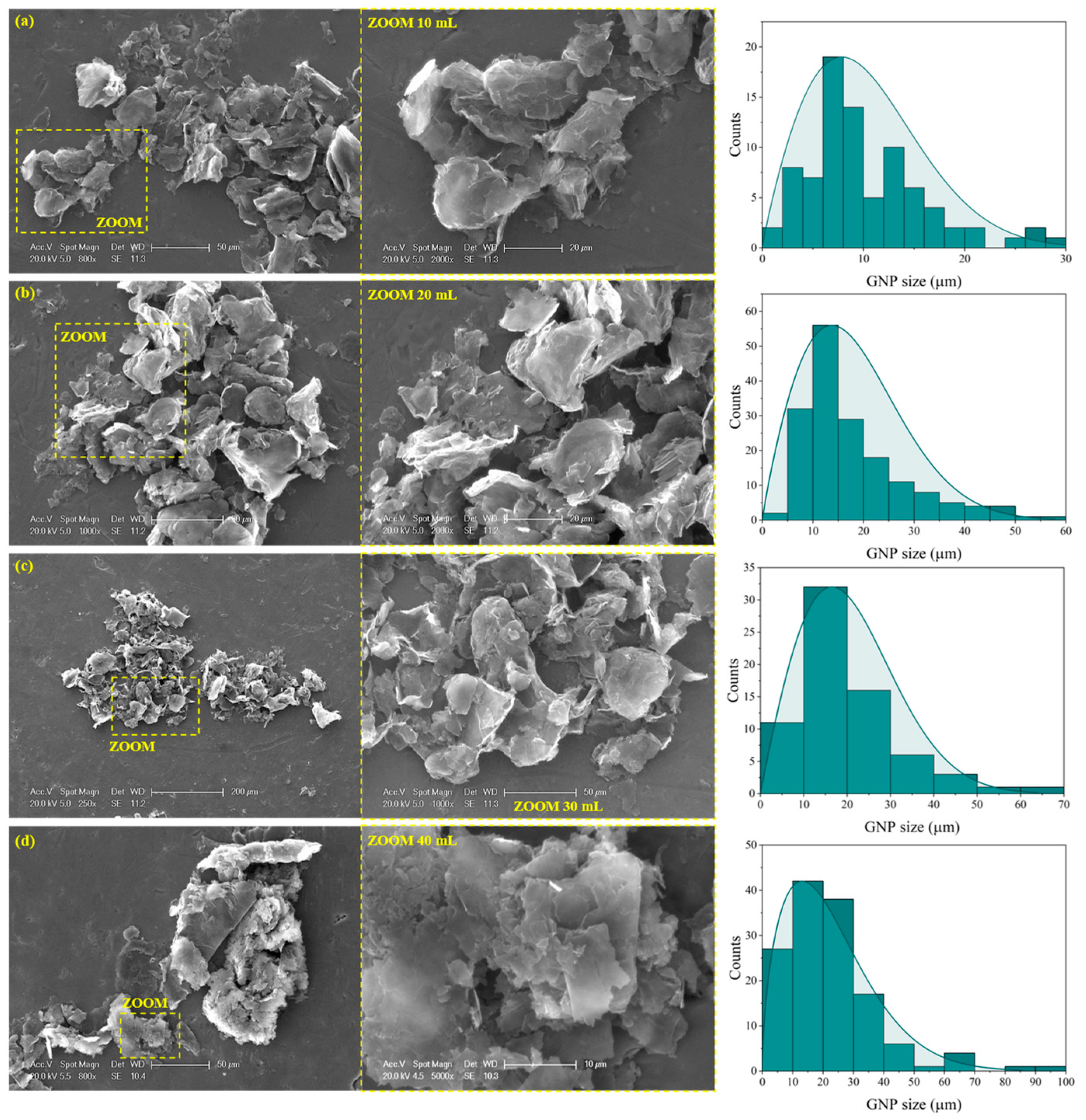
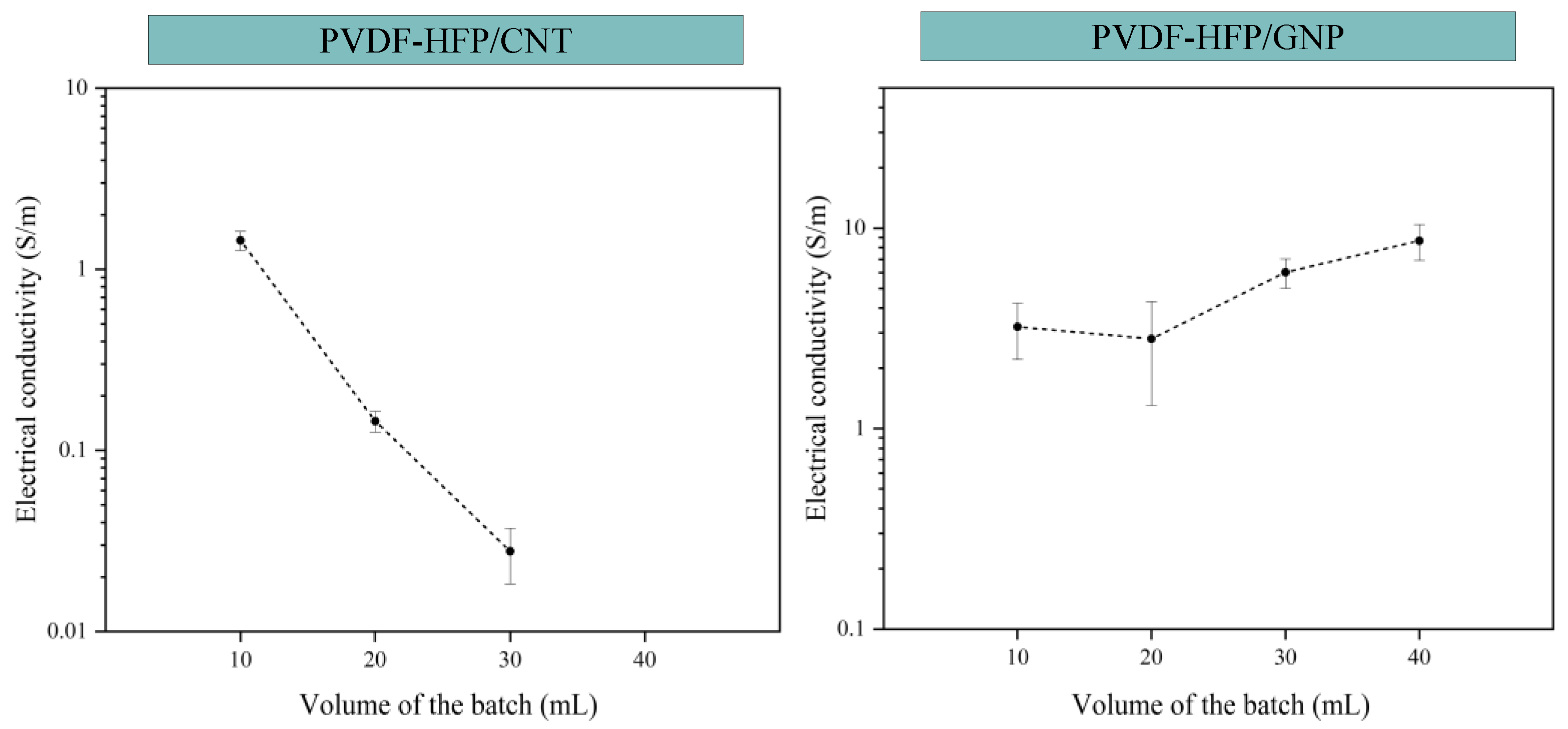

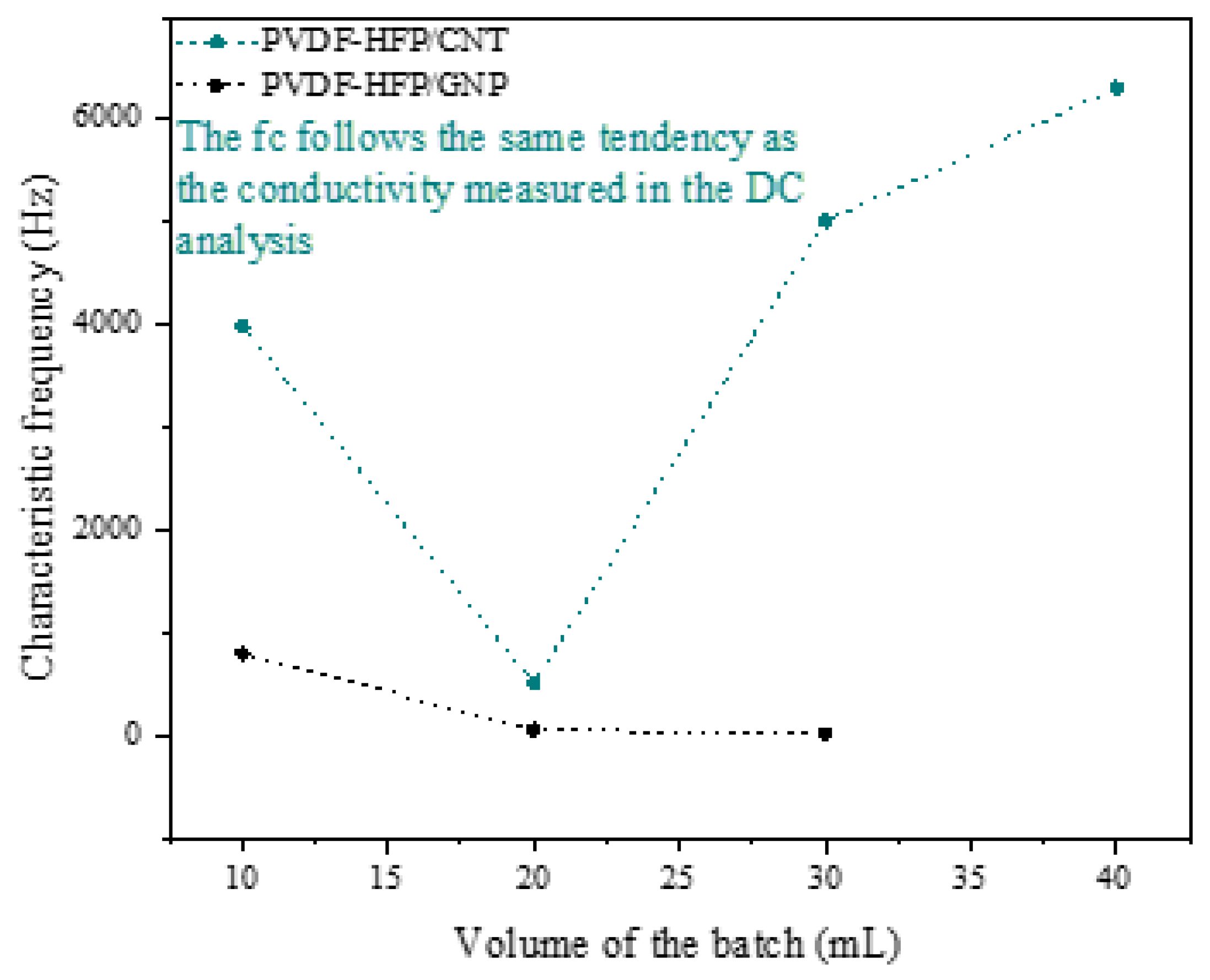
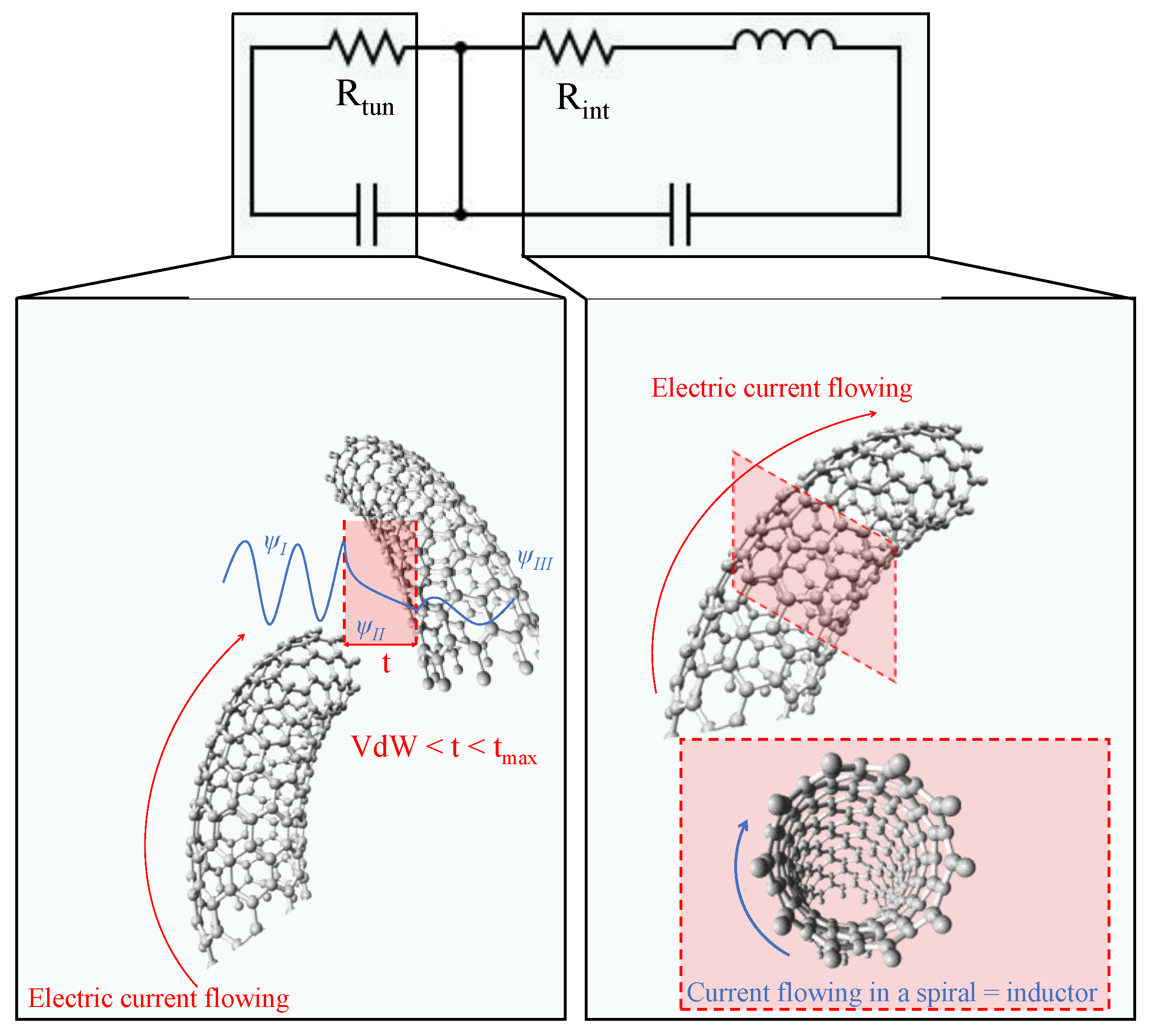
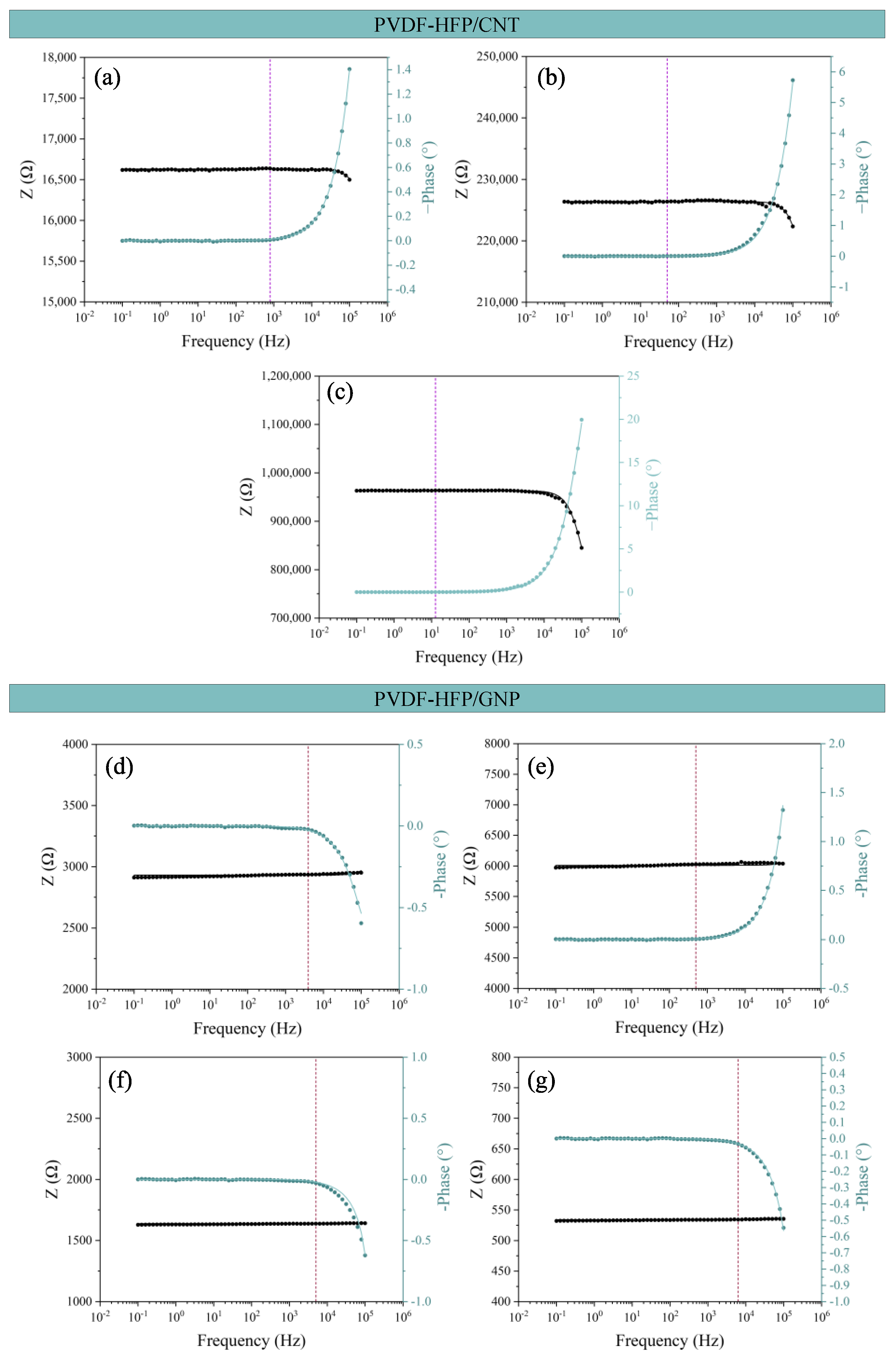
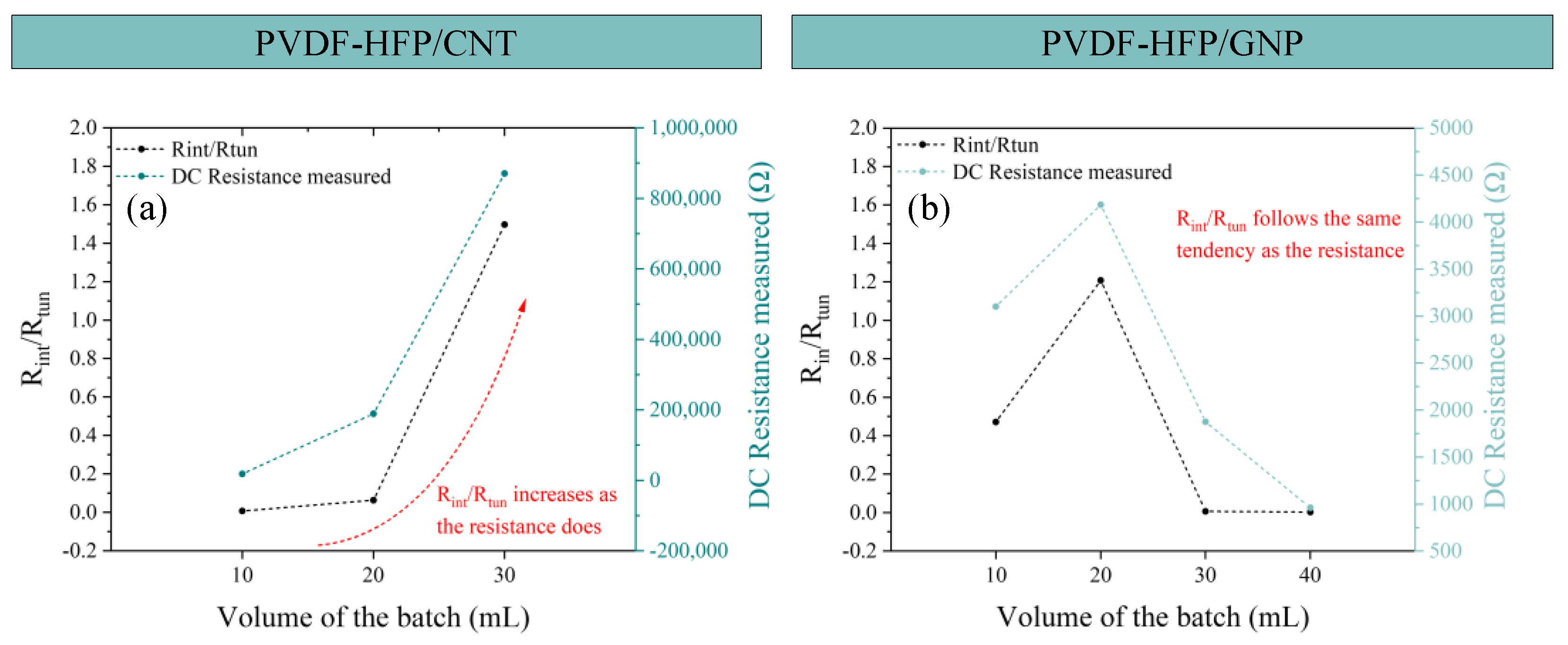

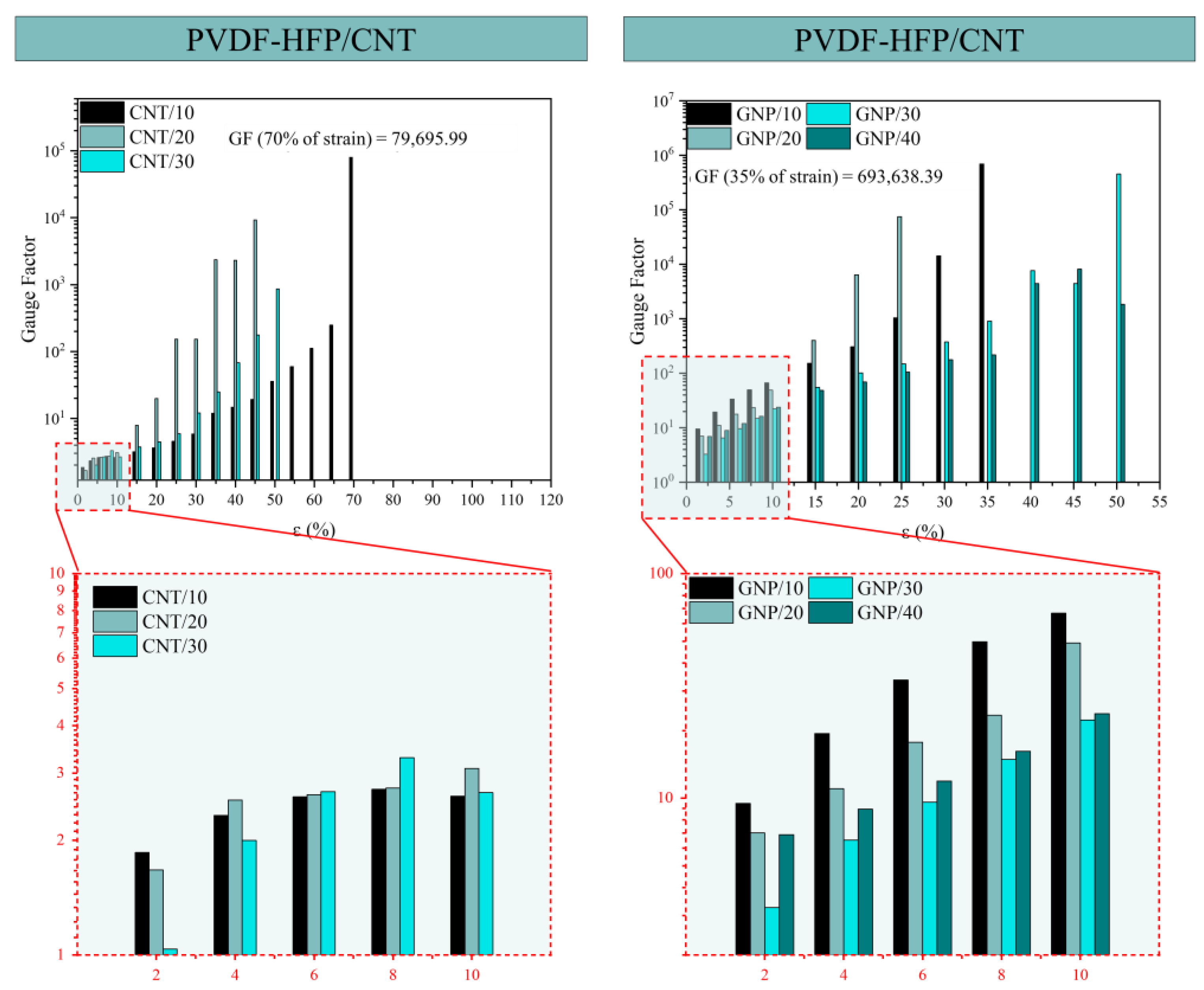
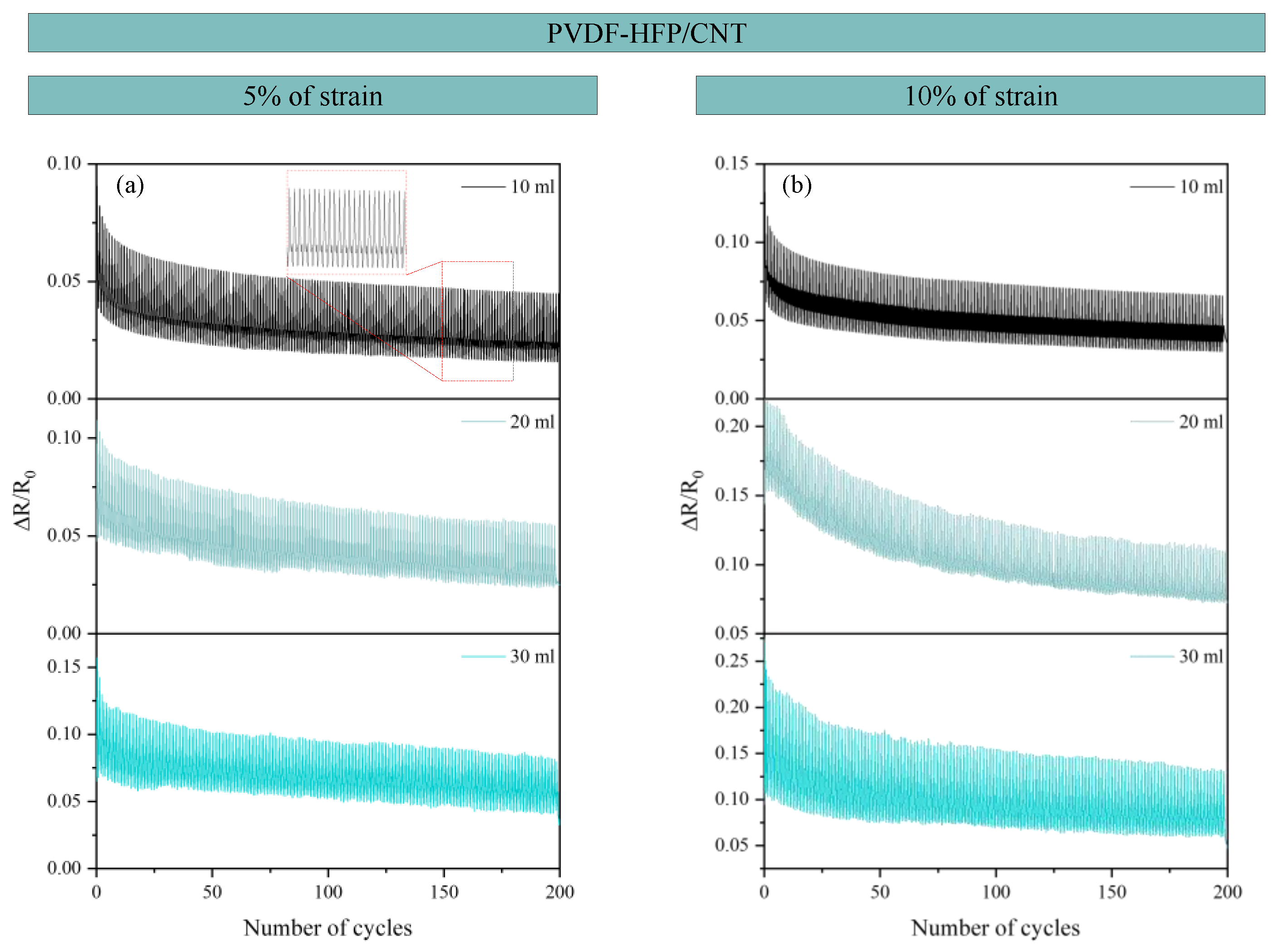
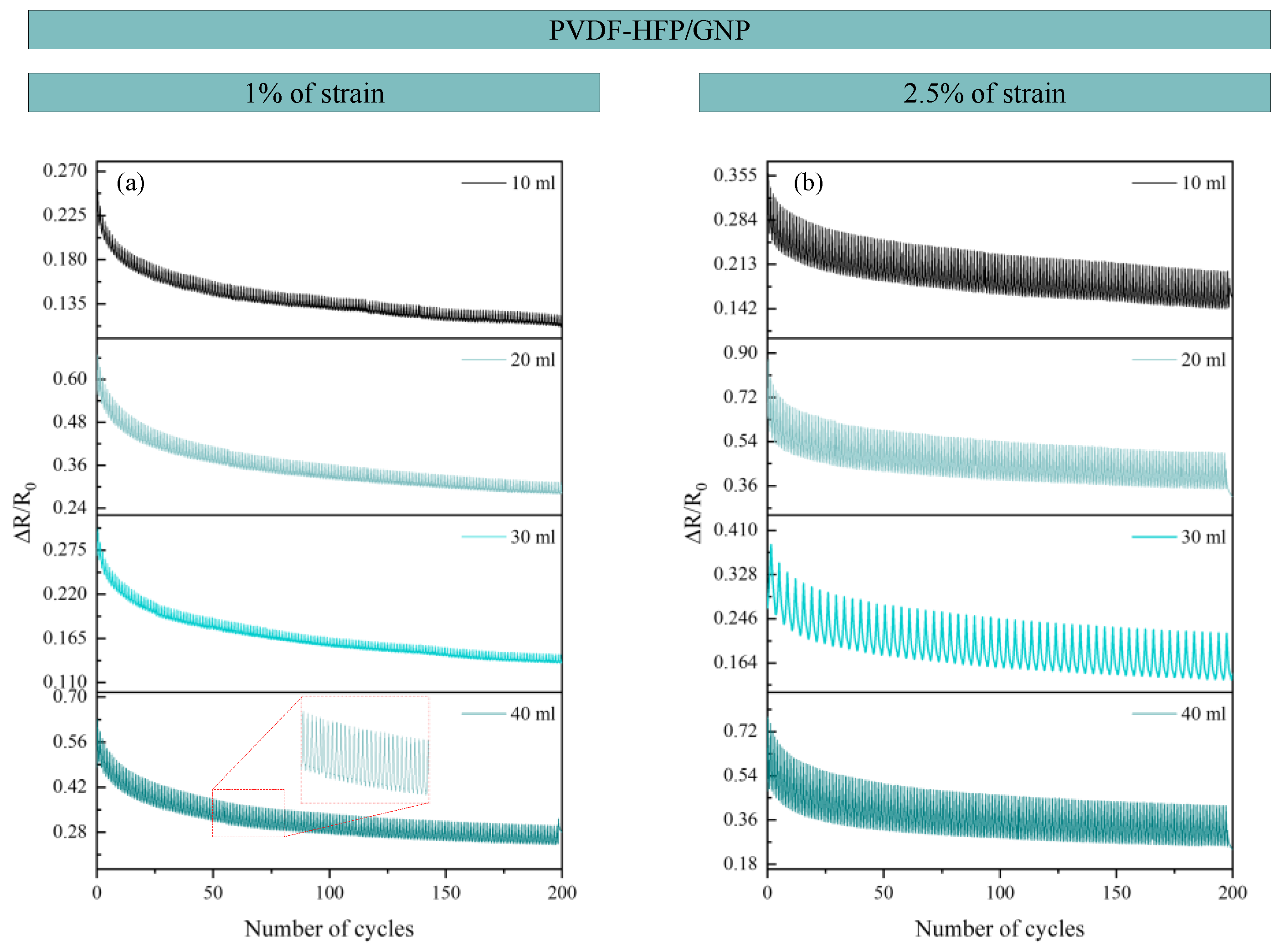
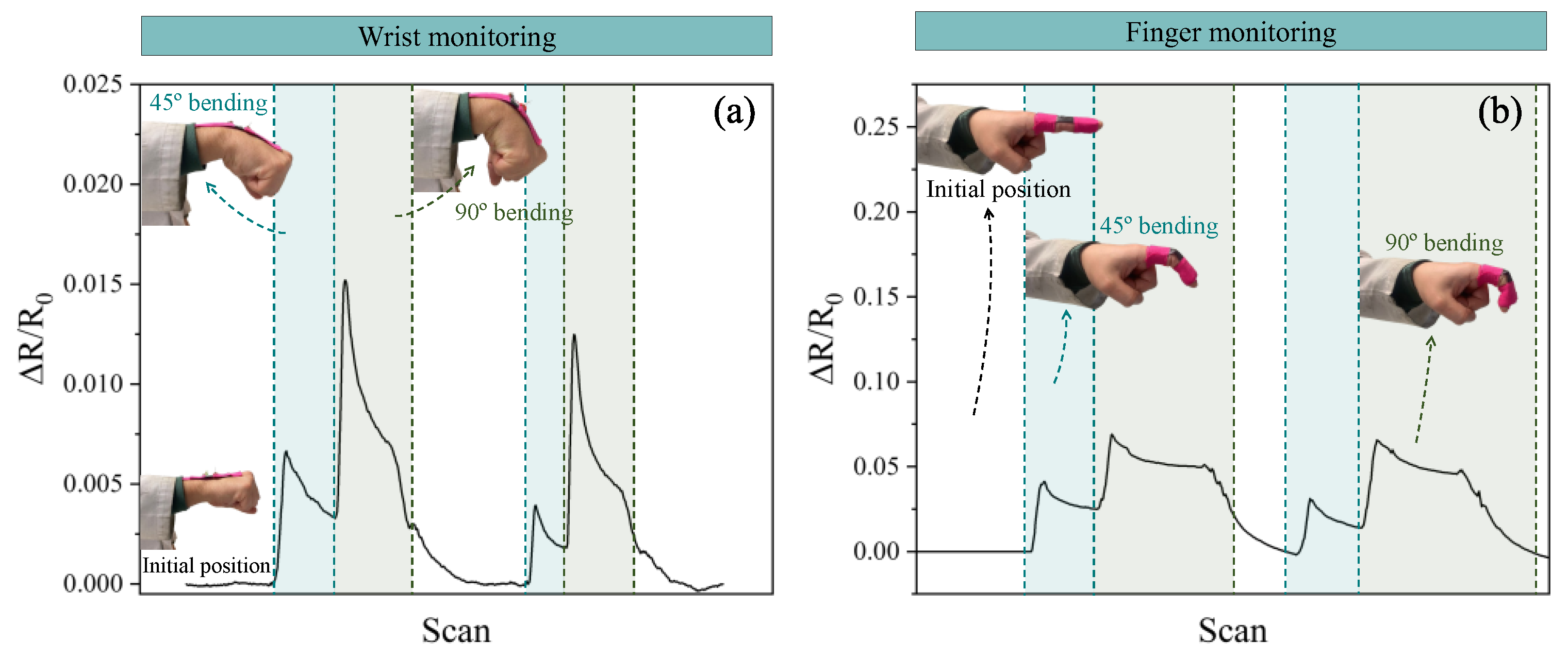
| Sample Nomenclature | wt. % CNTs | wt. % GNPs | Nano-Reinforcement: Triton X-100 Ratio | Batch Volume (mL) |
|---|---|---|---|---|
| CNT/10 | 0.1 | - | 1:20 | 10 |
| CNT/20 | 0.1 | 20 | ||
| CNT/30 | 0.1 | 30 | ||
| CNT/40 | 0.1 | 40 | ||
| GNP/10 | - | 6 | 1:2 | 10 |
| GNP/20 | 6 | 20 | ||
| GNP/30 | 6 | 30 | ||
| GNP/40 | 6 | 40 |
Disclaimer/Publisher’s Note: The statements, opinions and data contained in all publications are solely those of the individual author(s) and contributor(s) and not of MDPI and/or the editor(s). MDPI and/or the editor(s) disclaim responsibility for any injury to people or property resulting from any ideas, methods, instructions or products referred to in the content. |
© 2024 by the authors. Licensee MDPI, Basel, Switzerland. This article is an open access article distributed under the terms and conditions of the Creative Commons Attribution (CC BY) license (https://creativecommons.org/licenses/by/4.0/).
Share and Cite
Díaz-Mena, V.; Sánchez-Romate, X.F.; Sánchez, M.; Ureña, A. Effect of Sonication Batch on Electrical Properties of Graphitic-Based PVDF-HFP Strain Sensors for Use in Health Monitoring. Sensors 2024, 24, 2007. https://doi.org/10.3390/s24062007
Díaz-Mena V, Sánchez-Romate XF, Sánchez M, Ureña A. Effect of Sonication Batch on Electrical Properties of Graphitic-Based PVDF-HFP Strain Sensors for Use in Health Monitoring. Sensors. 2024; 24(6):2007. https://doi.org/10.3390/s24062007
Chicago/Turabian StyleDíaz-Mena, Victor, Xoan F. Sánchez-Romate, María Sánchez, and Alejandro Ureña. 2024. "Effect of Sonication Batch on Electrical Properties of Graphitic-Based PVDF-HFP Strain Sensors for Use in Health Monitoring" Sensors 24, no. 6: 2007. https://doi.org/10.3390/s24062007
APA StyleDíaz-Mena, V., Sánchez-Romate, X. F., Sánchez, M., & Ureña, A. (2024). Effect of Sonication Batch on Electrical Properties of Graphitic-Based PVDF-HFP Strain Sensors for Use in Health Monitoring. Sensors, 24(6), 2007. https://doi.org/10.3390/s24062007








